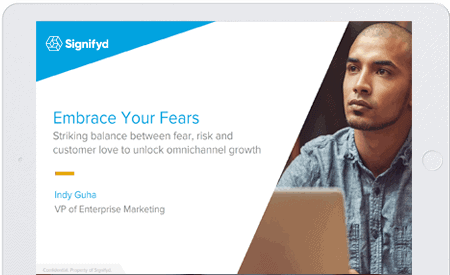We live in the now. The right now.
We don’t have time to talk. Or walk the dog. Or shop for groceries. Or sleep. And we definitely don’t have time to wait for an ecommerce site to load so we can buy what it is we came to buy.
In an ecommerce world where customer experience is better than ever before, but not quite good enough to match consumer expectations, seconds are the new hours. In fact, forget seconds. Site developers and ecommerce managers talk in terms of milliseconds.
“People expect to be able to interact with a page after four or five seconds,” says Rigel Cable, director of data analytics at digital agency Astound Commerce. “So when pages load at eight seconds or 10 seconds, I know personally that I’ve left a page before that point because I don’t know when it’s going to load. I don’t know if it’s broken.”
It’s the ecommerce merchant’s dilemma: Everybody is aware of the need for speed, but top-notch customer experience requires other elements — rich media, instructional videos, inventory insights, chat features, payment options, personalization engines and customer reviews. There are tools that reduce online friction by managing inventory, driving ecommerce order automation, assessing shoppers for installment plans, screening for fraud and on and on.
In fact, there is an endless number of add-ons — often provided by third-party vendors — aimed at making things better, but with the potential of making things worse — by slowing sites down
How to fix a slow website
Neither Yottaa nor Astound are companies to curse the poorly performing ecommerce site darkness. They are in the business of making ecommerce better. So, we gathered from the Astound and Yottaa teams some tips to keep your site performing at the highest level.
Adopt best practices: High-quality site performance doesn’t just happen. More isn’t always better. You can’t just add more tools to your site and expect it to be faster. Make sure images, scripts, code and page layout are optimized.
Focus on user experience before visual design: Make sure that you’re not just filling your site with visuals, but that you’re also building something with a very clean architecture.
Think mobile first: Consider how each feature will load on mobile — particularly when there is not a great connection. What will happen if there is not a quick load rate? “Make sure the answer isn’t, ‘Nothing will load,’” Cable says.
Do your homework: Research the third party technologies you plan to deploy on your site. “Not all third parties have great performance, so find the ones that do,” Buffone says.
Find a great partner to build great performance: Vendors like Yottaa are site-performance experts. They can make sure you have a process for improving site speed and that the way you load features is logical and efficient.
At Yottaa, a company dedicated to improving site performance, the magic number is three seconds. Consumers will accept a three-second load time, says Yottaa CTO and Founder Bob Buffone. Any longer and 57% of shoppers will leave a retailer’s site, according to Yottaa’s research. In fact, conversion drops 7% for each additional second beyond the three-second mark, according to the company’s “2019 Ecommerce 3rd Party Technology Index.”
After three seconds, you can almost hear the revenue ticking away.
It can be hard for some retailers to accept the fact that no matter how beautiful and inspirational their digital sites are, no matter how fantastic their products, no one is going to click “buy” if they have to wait longer than their daily elevator ride for a page to load.
Poor site performance will send your customers scurrying
Consumers have choices. Poor site performance means they’ll simply go elsewhere (Amazon, anyone?) to buy what they want. Brands with sluggish sites are literally their own worst enemy, Buffone explains. Take a luxury accessory seller.
“You’re probably also selling that great handbag at Macy’s and Nordstrom and if those sites are faster, why wouldn’t I, as the shopper, just buy from those sites? Now you just reduced your margin,” Buffone says.
There is some irony here. Often, retailers add features and turn to third-party vendors for solutions that are meant to improve customer experience, a goal that is universally embraced by ecommerce professionals. For one thing, online brands pay plenty to Google, Facebook, Amazon and others for digital ads to attract customers.
“Brands spend a great deal of money to get shoppers to their sites; they need to keep them there,” says Beth Moriarty, Yottaa’s vice president of product and corporate marketing. “They’re trying to compete with Amazon. How? By having rich imagery, explainer videos, dynamic reviews and ratings, and more. Plus, it’s all branded.”
But if the features are not deployed strategically and if third-party technologies are not loading efficiently, all the customer-experience effort can be for naught.
“Site performance is the first thing that impacts customer experience,” Buffone says. “Site speed is the first thing that customers understand about your brand. They’ll know your website is slow before they’ll know it’s good.”
Yottaa’s “2019 eCommerce 3rd Party Technology Index” is an effort to help retailers get a handle on the effect that nearly 1,000 third-party tools have on site performance. The company found that such solutions account for 70% of load time on ecommerce sites.
The index gives each tech solution a Performance Impact Rating, based on how long the technology takes to load and whether it delays a shopper’s ability to interact with the site. The solution receives a label, either “represents a consistent negative impact on performance,” “represents an inconsistent negative performance impact” or “represents little or no performance impact,” the category Signifyd qualified for.
Ecommerce Site speed opens the door to great customer experiences
The best news is that crowd-pleasing customer experience and high-performance ecommerce sites are not mutually exclusive.
“Things should be both functional and beautiful and immersive and fast,” Astound’s Cable says. “And I don’t think that having all of those things is impossible.”
Not surprisingly, planning is an important defense to weighing down a site with features that slow things down. Engineers and developers can assess the effects new additions and third-party integrations will have, Cable says. More important than what effect a new feature will have is being thoughtful about when it will have that effect.
“You have to balance web performance,” Buffone says, “and the way we typically do that is through the ability to schedule and prioritize. So, if you’re not prioritizing the digital elements on your site, then you’re most likely going to have poor performance.”
Think of a chatbot feature, for instance. It can provide a great customer experience. Someone is there to answer your questions about features, fit, alternative products and more. The shopper controls the conversation. But do you need to load the bot immediately?
“The first thing that people are going to do on a site isn’t click the chat button,” Buffone says. “But if you put it on the website immediately, there is a high probability that this could impact the user experience. And any impact on the user experience during the load is wasted because nobody is going to use the feature at that time.”
If a retailer instead loaded that chat feature when a customer would typically use it — say about four seconds into a visit — then you’re providing a great user experience and the third-party doesn’t damage the experience, he explains.
Yottaa, in fact, helps retailers manage the dozens of third-party tools they use to build great online experiences with a machine-learning solution that inventories the tools, determines when they should be deployed, monitors for delays and ensures that third-party features don’t diminish customer experience.
It is a key way to stay on top of a tech stack built to make things better to ensure that it doesn’t make things worse. It’s a challenge you don’t want to shy away from. In fact, you might want to tackle it now — by taking immediate action in the world of right now.
Photo by Getty











